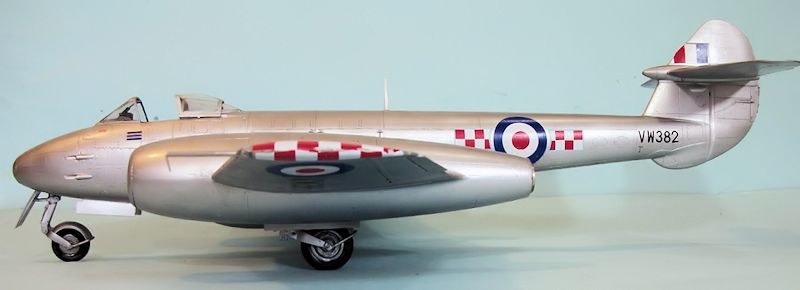
H-K Models 1/32 Meteor F.4
| KIT #: | |
| PRICE: | $ |
| DECALS: | |
| REVIEWER: | Tom Cleaver |
| NOTES: | Test Shot |

| HISTORY |
The Meteor F.4 was the result of three separate
lines of research that began shortly after 616 Squadron had taken delivery
of their Meteor F.1s in 1944.
The Aerodynamic Section at
R.A.E. Farnborough was studying ways to improve the high speed
characteristics of the Meteor; wind tunnel tests indicated a breakdown of
airflow around the engine nacelles at Mach .75, which resulted in a great
increase in drag and severe buffeting, with the center section completely
stalled.
Further experiments demonstrated that these conditions could
be delayed by
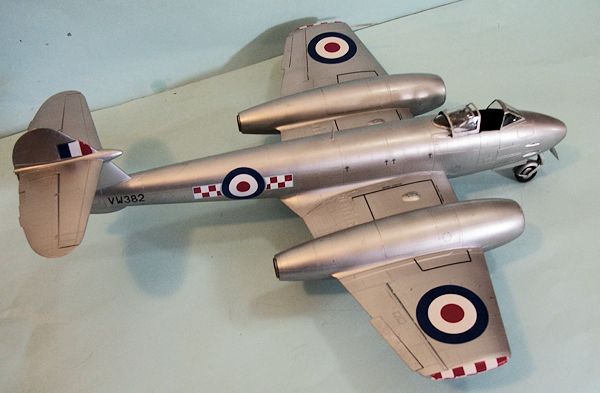 increasing
the length of the nacelles in front of and behind the wings.
Full scale trials on EE211 in November 1944
demonstrated a very useful increase in performance with the longer‑chord
nacelles.
increasing
the length of the nacelles in front of and behind the wings.
Full scale trials on EE211 in November 1944
demonstrated a very useful increase in performance with the longer‑chord
nacelles.
Development of the Derwent 5 ‑
a smaller version of the excellent Nene jet engine ‑ resulted in doubling
the thrust, compared with the Welland.
The
first prototype of the new Meteor was a modified F.3, EE360, which made its
maiden flight on July 17, 1945.
It showed a 111 m.p.h. increase in speed over the
standard F.3. All of this was so successful that the G.41 was ordered into
production in November 1945 as the Meteor F.4.
Airframe stress caused by the increase in speed was
dealt with by clipping each wing by two feet, ten inches, which improved the
rate of roll considerably, but raised take‑off and landing speeds while
reducing the rate of climb.
The Meteor F.4 was the first of the type to be exported, serving in the air forces of Argentina, Denmark, Egypt, Belgium and the Netherlands. The R.Aux.A.F. operated the F.4 until the mid‑1950s when the organization was abolished.
| THE KIT |
In answer to the many modelers who have
wondered why H-K Models is bringing out the Meteor F.4, which never saw
combat, as opposed to the F.8 which saw combat with two air forces and
served with many others, the answer is that this was one of the projects
originally developed with He Who Shall Not Be
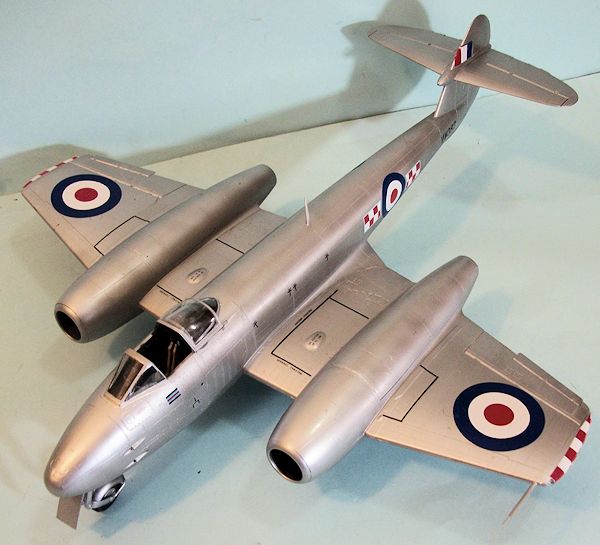 Named,
who was interested in this sub-type because it served with the Dutch Air
Force.
An F.8 is in development, and there is the possibility of
other sub-types of the Meteor being produced, depending on the commercial
success of this kit.
Named,
who was interested in this sub-type because it served with the Dutch Air
Force.
An F.8 is in development, and there is the possibility of
other sub-types of the Meteor being produced, depending on the commercial
success of this kit.
Overall, the kit is very simple, without
additional detail such as jet engines, though the design will allow modelers
to install an engine if such is produced by the aftermarket.
The cockpit is simple and accurate; since it will be
painted black, there will not be much to be seen there anyway.
Surface detailing is so petite that it is
difficult to see until paint has been applied, and then only in good
lighting conditions.
Modelers who have complained about Trumpeter's “mad
riveter,” and about “trench-like panel lines” will be happy with this.
Comparing the kit to the real Meteor F.4 on display
at Planes of Fame, the surface detail is accurate and highly realistic.
| CONSTRUCTION |
Assembly is easy.
Even without instructions, it only took me about
three hou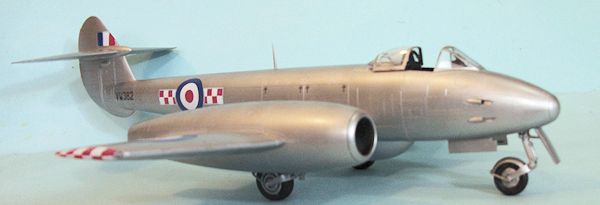 rs
to completely assemble this model.
I used some Mr.
Surfacer 1000 on the centerline seam of the fuselage
and on the engine nacelles.
Other than that there was no need for further
clean-up.
rs
to completely assemble this model.
I used some Mr.
Surfacer 1000 on the centerline seam of the fuselage
and on the engine nacelles.
Other than that there was no need for further
clean-up.
The Meteor F.4 is a tail sitter without
considerable weight, and H-K Models plans to provide a weight in the kit
that will take care of the problem.
I did not have the photo-etch, so I filled in
the speed brake areas and then re-scribed them.
| COLORS & MARKINGS |
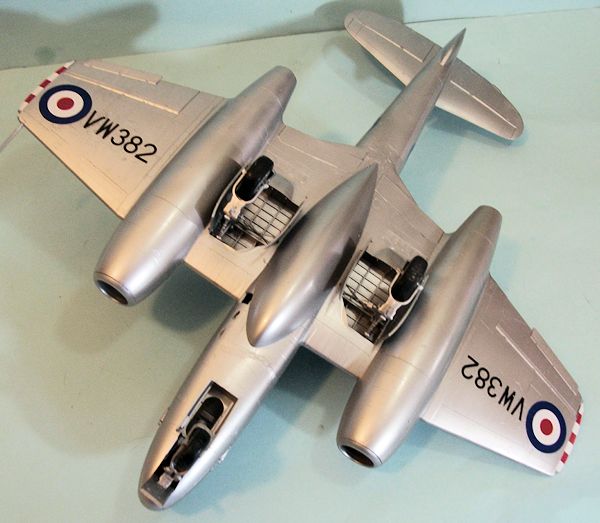 I pieced
together markings for a Meteor F.
Mk.
4 as operated by 56 Squadron circa 1948-50, using decals
from the spares box.
It has been confirmed that one of the markings options
for the kit will be 600 Squadron, R.Aux.A.F., which is particularly colorful.
I pieced
together markings for a Meteor F.
Mk.
4 as operated by 56 Squadron circa 1948-50, using decals
from the spares box.
It has been confirmed that one of the markings options
for the kit will be 600 Squadron, R.Aux.A.F., which is particularly colorful.
| CONCLUSIONS |
Overall, this is a simple kit that results in an outstanding model. H-K's Meteor F.4 is the best kit of the Meteor of any version in any scale.
October 2013
Thanks to Neil Yan at H-K Models for providing this test shot.
If you would like your product reviewed fairly and fairly quickly, please contact the editor or see other details in the Note to Contributors.